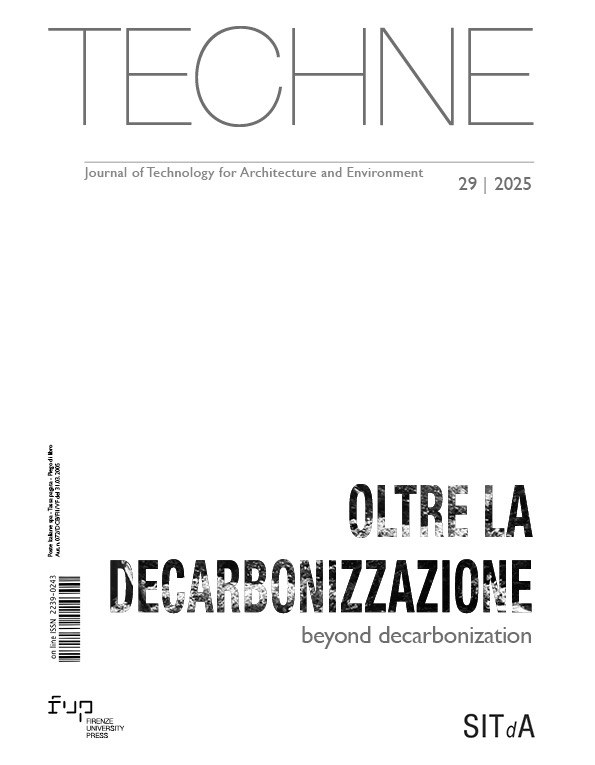Published 2025-07-31
Keywords
- Carbon storage,
- City-territory system,
- Engineered wood,
- Renewable resources,
- Mitigation strategies
How to Cite
Copyright (c) 2025 Elisa Zatta

This work is licensed under a Creative Commons Attribution 4.0 International License.
Abstract
Timber is currently a trending topic in the debate concerning our built environment’s carbon neutrality, due to its renewable nature and the potential to store carbon. Nevertheless, this premise is sometimes inaccurately interpreted, as proven by the recently emerging concept of buildings becoming carbon sinks. The paper explores three fields in which misconceptions appear to be grounded, namely the inaccurate use of vocabulary about carbon storage in timber, the renewable-based assumption disregarding carbon transfer patterns and the finite nature of forests, and the competing market sectors relying on a resource with uncertain availability. By identifying existing and future trade-offs, the contribution points out how the carbon neutrality of urban areas cannot disregard the territory they extract resources from.
Downloads
References
- Andersen, C.E., Rasmussen, F.N., Habert, G. and Birgisdóttir, H. (2021) “Embodied GHG Emissions of Wooden Buildings – Challenges of Biogenic Carbon Accounting in Current LCA Methods”, Front. Built Environ 7, 729096. Available at: 10.3389/fbuil.2021.729096 (Accessed on 03/02/2025). DOI: https://doi.org/10.3389/fbuil.2021.729096
- Arehart, J. H., Hart, J., Pomponi, F., and D’Amico, B. (2021). “Carbon sequestration and storage in the built environment”, Sustainable Production and Consumption n. 27, pp. 1047–1063. Available at: https://doi.org/10.1016/j.spc.2021.02.028 (Accessed on 03/02/2025). DOI: https://doi.org/10.1016/j.spc.2021.02.028
- European Commission (EC) (2018), A sustainable bioeconomy for Europe: strengthening the connection between economy, society and the environment, Luxembourg: Publications Office of the European Union. Available at: https://doi.org/10.2777/792130 (Accessed on 03/02/2025).
- European Commission (EC) (2021), New EU Forest Strategy for 2030. COM (2021) 572 final. Brussels, Belgium. Available at: https://eur-lex.europa.eu/legal-content/EN/TXT/?uri=celex:52021DC0572 (Accessed on 03/02/2025).
- European Parliament (EP) (2018), Regulation (EU) 2018/841 of 30 May 2018 on the inclusion of greenhouse gas emissions and removals from land use, land use change and forestry in the 2030 climate and energy framework and amending Regulation (EU) No 525/2013 and Decision No 529/2013/EU. OJ L 156, 19.6.2018, pp. 1–25.
- Göswein, V., Arehart, J., Phan-huy, C., Pomponi, F. and Habert, G. (2022). “Barriers and opportunities of fast-growing biobased material use in buildings”, Buildings and Cities vol.3 (1), pp. 745–755. Available at: https://doi.org/10.5334/bc.254 (Accessed on 03/02/2025). DOI: https://doi.org/10.5334/bc.254
- Grassi, G., Fiorese, G., Pilli, R., Jonsson, K., Blujdea, V., Korosuo, A. and Vizzarri, M. (2021), Brief on the role of the forest-based bioeconomy in mitigating climate change through carbon storage and material substitution, European Commission, JRC124374. Available at: https://publications.jrc.ec.europa.eu/repository/handle/JRC124374 (Accessed on 03/02/2025).
- Hetemaki, L., D’Amato, D., Giurca, A., and Hurmekoski E. (2024), “Synergies and trade-offs in the European forest bioeconomy research: State of the art and the way forward”, Forest Policy and Economics 163, 103204. Available at: https://doi.org/10.1016/j.forpol.2024.103204 (Accessed on 03/02/2025). DOI: https://doi.org/10.1016/j.forpol.2024.103204
- Hoxha, E., Passer, A., Ruschi Mendes Saade, M., Trigaux, D., Shuttleworth, A., Pittau, F., Allacker, K. and Habert, G. (2020), “Biogenic carbon in buildings: a critical overview of LCA methods”, Buildings and Cities, vol.1 (1), pp. 504–524. Available at: https://doi.org/10.5334/bc.46 (Accessed on 03/02/2025). DOI: https://doi.org/10.5334/bc.46
- IPCC (2019). 2019 Refinement to the 2006 IPCC Guidelines for National Greenhouse Gas Inventories: Glossary. Available at: https://www.ipcc.ch/report/2019-refinement-to-the-2006-ipcc-guidelines-for-national-greenhouse-gas-inventories/ (Accessed on 03/02/2025).
- Le Den, X., Steinmann, J., Kovacs, A., Kockat, J., Toth, Z., Röck, M., Allacker K. (2023), Supporting the development of a roadmap for the reduction of whole life carbon of buildings – Final report. Available at: https://op.europa.eu/s/zQh7 (Accessed on 03/02/2025).
- Leturcq, P. (2020), “GHG displacement factors of harvested wood products: the myth of substitution”, Scientific Reports 10, 20752. Available at: https://doi.org/10.1038/s41598-020-77527-8 (Accessed on 03/02/2025). DOI: https://doi.org/10.1038/s41598-020-77527-8
- Mancuso S. (2023), Fitopolis, la città vivente, Bari, Laterza
- Pomponi, F., Hart, J., Arehart, J.H. and D’Amico, B. (2020), “Buildings as a Global Carbon Sink? A Reality Check on Feasibility Limits”, One Earth Vol. 3, pp. 157-161. Available at: https://doi.org/10.1016/j.oneear.2020.07.018 (Accessed on 03/02/2025). DOI: https://doi.org/10.1016/j.oneear.2020.07.018
- Ramage, M., Burridge, H., Busse-Wicher, M., Fereday, G., Reynolds, T., Shah, D., Wu, G., Yu, L., Fleming, P., Densley-Tingley, D., Allwood, J., Dupree, P., Linden, P.F., Scherman, O. (2016), “The wood from the trees: The use of timber in construction”, Renewable and Sustainable Energy Reviews Vol. 68, pp. 333–359. Available at: http://dx.doi.org/10.1016/j.rser.2016.09.107 (Accessed on 03/02/2025). DOI: https://doi.org/10.1016/j.rser.2016.09.107
- Sennett R. (2023), Building and Dwelling: Ethics for the City, New Haven, London, Yale University Press. DOI: https://doi.org/10.12987/9780300274769
- United Nations Environment Programme (UNEP) and Yale Center for Ecosystems + Architecture (YCE+A) (2023), Building Materials and the Climate: Constructing a New Future. United Nations Environment Programme, Nairobi. Available at: https://wedocs.unep.org/20.500.11822/43293 (Accessed on 03/02/2025).
- United Nations (UN) and Food and Agriculture Organisation (FAO) (2021), Circularity concepts in forest-based industries, United Nations, Geneva. Available at: https://unece.org/forests/publications/circularity-concepts-forest-based-industries (Accessed on 03/02/2025).
- United Nations Environment Programme (UNEP) and Global Alliance for Buildings and Construction (GABC), Global Status Report for Buildings and Construction – Beyond foundations: Mainstreaming sustainable solutions to cut emissions from the buildings sector. Available at: https://wedocs.unep.org/20.500.11822/45095 (Accessed on 03/02/2025).






